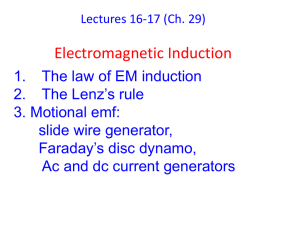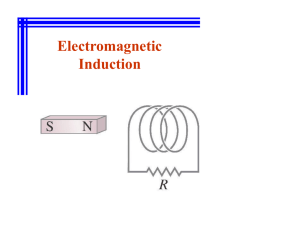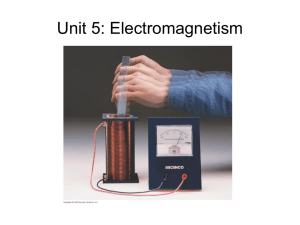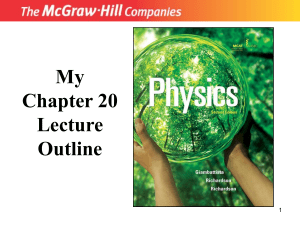Chapter 20.1 Induced EMF and magnetic flux
advertisement
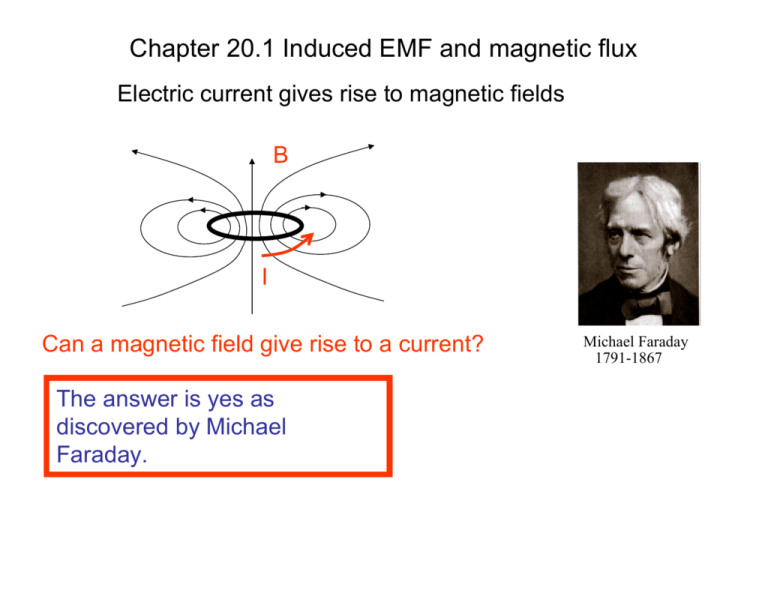
Chapter 20.1 Induced EMF and magnetic flux Electric current gives rise to magnetic fields B I Can a magnetic field give rise to a current? The answer is yes as discovered by Michael Faraday. Michael Faraday 1791-1867 Chapter 20.1 Induced EMF and magnetic flux × Moving magnetic fields induce currents B × Change the strength of B: Induced current B × B Induced EMF! Moving current loop induces currents v Chapter 20.1 Induced EMF and magnetic flux SI units: weber (Wb) Fig. 20.2 20.2&20.4 Faraday’s law of induction Faraday’s law: The induced emf, ɛ, in a closed wire is equal to the time rate of change of the magnetic flux, ΦB. An induced emf, ɛ, always gives rise to a current whose magnetic field opposes the original change in magnetic flux. Lenz’s law Faraday’s Law and Lenz’s Law both state that a loop of wire will want its magnetic flux to remain constant. Michael Faraday 1791-1867 2. A circular loop with a radius of 0.20 m is placed in a uniform magnetic field B=0.85 T. The normal to the loop makes an angle of 30o with the direction of B. The field increases to 0.95 T what is the change in the magnetic flux through the loop? Change in flux? ∆Φ B = B ' A 'cosθ '− BA cosθ 30o B=0.85T A ' = A = π R2 θ ' = θ = 30o ∆Φ B = A cos θ (B '− B ) = π R 2 cos30(B '− B ) B’=0.95T ∆Φ B = π (0.2)2 cos30(0.95 − 0.85) ∆Φ B = 1.1x10 −2Wb 8. A circular coil with a radius of 20 cm is in a field of 0.2 T with the plane of the coil perpendicular to the field. If the coil is pulled out of the field in 0.30 s find the average emf during this interval ∆Φ B BA cos θ − 0 =N ε =N ∆t ∆t N= 1 B cosθ= 1 πR2 A= B=0 Bπ R 2 0.2π (0.2)2 ε= = 0.3 ∆t ε = 8.4 x10−2V 20.3 Motional emf A voltage is produced by a conductor moving in a magnetic field Charges in the conductor experience a force upward x x F x x x x x x x x x x x x ∆V x v L x x x F = qvB The work done in moving a charge from bottom to top W = FL = qvBL x B into the page x The potential difference is ∆V = W = vBL q 20.3 Motional emf A voltage is produced by a conductor moving in a magnetic field Charges in the conductor experience a force upward x x x F x x x x x ∆V x x v x x x x L x x x F = qvB x V o lt a g e velocity W = FL = qvBL x B into the page x The potential difference is ∆V = W = vBL q 20.3 Motional emf The potential difference can drive a current through a circuit The emf arises from changing flux due to changing area according to Faraday’s Law ∆x ∆AB ∆Φ B ∆V = vLB = = =ε LB = ∆t ∆t ∆t wire x R ∆V x I F x x x x x x x x v ε L x x x x x x x x x x Changing Magnetic Flux B into the page BLv = I= R R 18. R= 6.0 Ω and L=1.2 m and B=2.5 T. a) What speed should the bar be moving to generate a current of 0.50A in the resistor? b) How much power is dissipated in R? c) Where does the power come from? ε wire x R ∆V x x a) I F x x x x x x v x x x x x x L x BLv I= = R R IR 0.5(6.0) = v= BL 2.5(1.2) v = 1.0m / s x x x B into the page x b) P = I 2R = (0.5)2 (6.0) P = 1.5W c) Work is done by the force moving the bar 20.4 Lenz’s law revisited Lenz’s Law The polarity of the induced emf is such that it induces a current whose magnetic field opposes the change in magnetic flux through the loop. i.e. the current flows to maintain the original flux through the loop. B increasing in loop Bin B S N V ε I Bin acts to oppose the - change in flux + Current direction that produces Bin is as shown (right hand rule) Emf has the polarity shown. ε drives current in external circuit. 20.4 Lenz’s law revisited Now reverse the motion of the magnet The current reverses direction B decreasing in loop Bin S N V B ε I Bin acts to oppose the + change in flux - Current direction that produces Bin is as shown (right hand rule) Emf has the polarity shown. 20.4 Lenz’s law revisited Lenz’s Law and Reaction Forces Fmc Fcm Bin B S N V N A force is exerted by the magnet on loop to produce the current S I A force must be exerted by the current on the magnet to oppose the change The current flowing in the direction shown induces a magnetic dipole in the current loop that creates a force in the opposite direction 20.5 Generators Flux through a rotating loop in a B field Normal to the plane θ B ε The flux through the loop Φ B = BA cos θ θ = ωt ω = angular velocity (radians/s) B 20.5 Generators ∆Φ B Relation between ΦB and ∆t BA Φ B = BA cos ωt ΦB t -BA BAω ∆Φ B ∆t -BAω ∆Φ B = −BAω sin ωt ∆t t proportional to ω 20.5 Generators The emf generated by a loop of N turns rotating at constant angular velocity ω is ∆Φ B ε = −N ∆t ε = NBAω sin ω t NBAω ε 0 t -NBAω 20.5 Generators 35. In a model ac generator, a 500 turn rectangular coil 8.0 cmx 20 cm rotates at 120 rev/min in a uniform magnetic field of 0.60 T. a) What is the maximum emf induced in the coil? ε = NBAω sin ω t The maximum value of ε ε max = NBAω ε max (120 x 2π ) = (500)(0.6)(0.08 x 0.2) = 60V 60 20.5 Generators Alternating Current (AC) generator Rotational Work 20.5 Generators Direct Current (DC) generator 20.5 Generators A generator is motor acting in reverse I ε drives rotation DC motor 20.6 Self-Inductance • a property of a circuit carrying a current • a voltage is induced that opposes the change in current • used to make devices called inductors Self- inductance of a circuit a reverse emf is produce by the changing current ∆Φ B ε =− ∆t 20.6 Self-Inductance Self-inductance of a coil + ε - B increases, B ∆B ∆t changes magnetic flux in the coil, I Current increasing ∆Φ B A∆B = ∆t ∆t Produces emf in coil ∆Φ B A∆B ε = −N = −N ∆t ∆t The direction of the induced emf opposes the change in current. 20.6 Self-Inductance A changing current in a coil induces an emf that opposes the change + - - ε + I I I increasing induced emf opposes I I decreasing induced emf supports I ε 20.6 Self-Inductance Inductance L is a measure of the The self-induced emf is self-induced emf ∆Φ B ε = −N ∆t ε but I Current increasing ∆Φ B ∆I ∝ ∆t ∆t proportionality constant is L ∆I ε = −L ∆t L is a property of the coil, Units of L , Henry (H) Vs A 20.6 Self-Inductance Inductance of a solenoid with N turns and length ℓ, wound around an air core (assume the length is much larger than the diameter). ∆B ∆t l A ∆I ∆t N Φ B = BA = µo IA l ∆Φ B N ∆I = µo A ∆t l ∆t ∆Φ B N 2 ∆I ∆I = − µo A = −L ε = −N ∆t l ∆t ∆t N2 L = µo A l inductance proportional to N squared x area/length 20.6 Self-Inductance An air wound solenoid of 100 turns has a length of 10 cm and a diameter of 1 cm. Find the inductance of the coil. l= 10 cm d=1 cm I 2 2 2 N N d L = µo A = µo π l l 4 2 2 −7 4π 10 (100) π (0.01) −5 L= = 1.0 x10 H 0.1(4) 20.7 RL circuits The inductor prevents the rapid buildup of current ∆I ε = −L ∆t But at long time does not reduce the current, ∆I ∆t =0 at t=∞ − t τ I = Io (1 − e ) L τ= Applications of Inductors: R Reduce rapid changes of current in circuits Produce high voltages in automobile ignition. 20.8 Energy stored in a magnetic field Energy is stored in a magnetic field of an inductor. Bo B increasing B=0 I ε I=Io Work is done against ε to produce the B field. This produces a change in the PE of the inductor 1 2 PEL = LI 2 This stored PE can be used to do work


